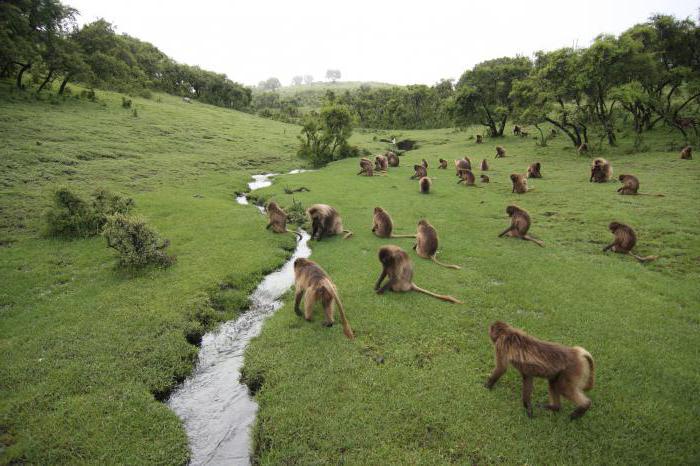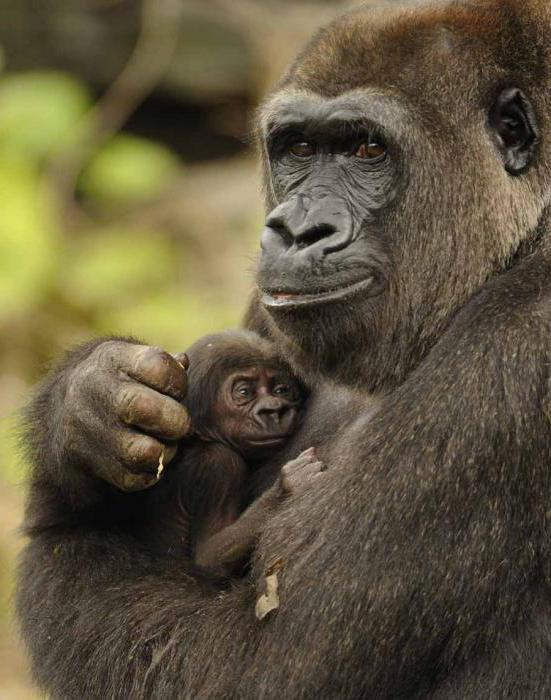Primates are a detachment included in the class of mammals, a type of chordate animal (vertebrate subtype). The class of mammals is characterized by live births, feeding the baby with milk, bearing it in the uterus. All representatives of this class are homoothermal, that is, their body temperature is constant. In addition, their metabolic rate is high. In addition to the middle and inner, all mammals also have an outer ear. Females have mammary glands.
Primates (semi-monkeys and monkeys) of all mammals differ, perhaps, the greatest wealth and variety of forms. However, despite the differences between them, many structural features of their bodies are similar. They developed in a long process of evolution as a result of a tree lifestyle.
Limbs of primates
Primates are animals that have a five-fingered grasping limb, well developed. It is adapted for climbing representatives of this detachment along the branches of trees. All of them have a clavicle, and the ulnar and radius are completely separated, which provides a variety of movements and mobility of the forelimb. The thumb is also movable. In many species it can be contrasted with the rest. Finger phalanges are provided with nails. In forms of primates with claw-shaped nails, or those that have claws on only some fingers, the thumb is characterized by the presence of a flat nail.
The structure of primates
When moving on the surface of the earth, they rely on the entire foot. In primates, a reduction in the sense of smell is associated with tree life, as well as a good development of the organs of hearing and vision. They have 3-4 nasal concha. Primates are mammals whose eyes are directed forward, eye sockets (lemurs, tupas) are separated by the periorbital ring from the temporal fossa, or by the bony septum (monkeys, tarsiers). The lower primates on the face have 4-5 groups of vibrissa (tactile hair), the higher - 2-3. In monkeys, as well as in humans, skin combs are developed on the entire plantar and palmar surface. However, in semi-monkeys they are only on the pillows. A variety of functions that have front limbs, as well as the active life of primates led to a strong development of their brain. And this means an increase in the volume of the skull in these animals. However, large, well-developed cerebral hemispheres with many convolutions and furrows have only higher primates. The lower ones have a smooth brain, there are few convolutions and furrows in it.

Hair and tail
The species of this detachment have thick hair. Semi-monkeys have an undercoat, however, in most representatives of primates, it is poorly developed. The coat and skin of many species are brightly colored, the eyes are yellow or brown. Their tail is long, however, there are also tailless and short-tailed forms.
Food
Primates are animals that feed mainly on mixed foods, in which vegetable predominates. Some species are insectivorous. The stomach in primates, in connection with a mixed type of nutrition, is simple. They have 4 types of teeth - fangs, incisors, large (molars) and small (premolars) molars, as well as molars with 3-5 tubercles. A complete change of teeth occurs in primates, it applies to both permanent and dairy.
Body size
Significant variations are noted in the body sizes of representatives of this order. The smallest primates are mouse lemurs, while the growth of gorillas reaches 180 cm and above. The body weight of males and females is different - males are usually larger, although there are many exceptions to this rule. The family of some monkeys consists of several females and a male. Since body weight is an advantage for the latter, there is a natural selection associated with its increase. For example, a Hanuman male can collect an entire harem consisting of 20 females, a very large family. Primates are forced to guard their harem from other males. Moreover, in the host family, body weight reaches 160% of the female’s mass. In other species, in which males usually mate with only one female (for example, gibbons), representatives of different sexes do not differ in size. Sexual dimorphism is very weakly expressed in lemurs.

In the struggle for paternity, an important role is played not only by the size of the body in such a detachment as primates. These are animals whose fangs serve them as powerful weapons. Males use them in aggressive demonstrations and fights.
Breeding primates and offspring
Primates breed year round. Usually one cub is born (in lower forms, there may be 2-3). Large species of primates breed less often, but live longer than their smaller relatives.
Already at the age of one year, mouse lemurs are able to breed. Two cubs are born each year. The body weight of each of them is about 6.5 g. Pregnancy lasts 2 months. 15 years is a record of longevity of this species. The female gorilla, on the contrary, becomes sexually mature only by the age of 10. One cub is born, whose body weight is 2.1 kg. Pregnancy lasts 9 months, after it a second pregnancy can occur only after 4 years. Usually gorillas live up to 40 years.

Common for various species of monkeys, with significant species differences, is a small offspring. The growth rate of young animals in representatives of this order is very low, much lower than that observed in other mammals with similar body weight. It is difficult to say what is the reason for this feature. Perhaps it should be sought in the size of the brain. The fact is that the most energy-intensive in the body are precisely the brain tissue. In large primates, a high level of metabolism is observed in it, which reduces the rate of development of the reproductive organs, as well as the growth of the body.
Addiction to infanticide
In primates, due to low breeding rates, a tendency to infanticide is pronounced. Often the males kill the cubs that the female gave birth to from other males, since the lactating individual cannot conceive again. Males, which are at the peak of physical development, are limited in attempts to reproduce. Therefore, they do everything possible in order to preserve their genotype. A male monkey, for example, Hanuman, has only 800 days out of 20 years of life for procreation.
Lifestyle
Squad primates, as a rule, lives on trees, but there are semi-terrestrial and terrestrial species. Representatives of this detachment have a daily lifestyle. Usually it is herd, rarely single or doubles. They mainly live in the subtropical and tropical forests of Asia, Africa and America, and are also found in alpine regions.
Classification of primates
About 200 species of modern primates are known. There are 2 suborders (monkeys and half-monkeys), 12 families and 57 genera. According to the classification that is most common at present, the primates include tupai, forming an independent family. These primates, together with tarsiers and lemurs, constitute a suborder of semi-monkeys. They connect through lemurs insectivorous animals with modern primates, recalling what ancestors were in antiquity of the latter.
Primates: evolution
It is believed that the ancestors of modern primates were insectivorous primitive mammals, similar to the dormant species that exist today. Their remains were found in Mongolia, in the Upper Cretaceous sediments. Apparently, these ancient species lived in Asia, from which they settled in other places in North America and the Old World. Here, primates evolved to long-hauls and lemurs. Evolution of the original forms of monkeys of the Old and New Worlds, apparently, was from primitive long-hauls (some authors consider the ancient lemurs to be the ancestors of monkeys). Regardless of the monkeys found in the Old World, American primates arose. Their ancestors from North America entered the South. Here they specialized and developed, adapting to an exclusively arboreal lifestyle. According to many biological and anatomical features, people are the highest primates. We make up a separate family of people with a kind of person and only one species - the modern intelligent.
The practical importance of primates
Modern primates are of great practical importance. Since ancient times, they have attracted the attention of man as amusing living beings. Monkeys were hunted. In addition, these mammals were put up for sale for home entertainment or at the zoo. Primates today are even eaten! Aborigines today eat the meat of many monkeys. Semi-monkey meat is also considered very tasty. Skins of certain species are used today for dressing various things.
The primates squad in recent years has become increasingly important in medical and biological experiments. These animals show great resemblance to humans in many anatomical and physiological characteristics. Moreover, not only humanoid primates have this similarity, but also lower ones. Representatives of this detachment are even susceptible to the same diseases as we (tuberculosis, dysentery, diphtheria, poliomyelitis, tonsillitis, measles, etc.), which generally proceed in the same way as ours. That is why some of their organs are used today in the treatment of people (in particular, the kidneys of green monkeys, macaques and other monkeys - a breeding ground for viruses, which, after appropriate treatment, are then turned into a polio vaccine).